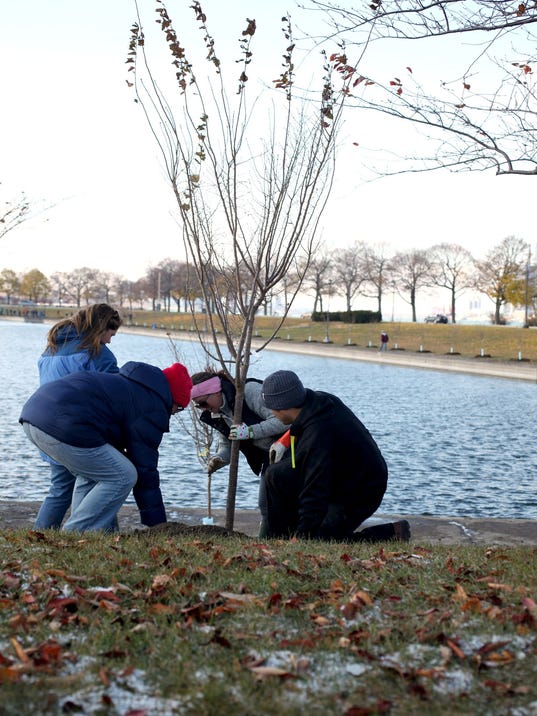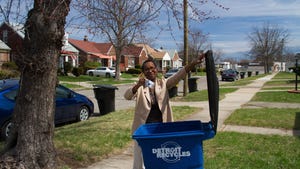This city is fast becoming a remarkable success story. We see it first hand traveling there fairly frequently. As asked here by the writer, what makes a city green? Building a heart and soul around sustainability is the very foundation. All good things can grow from there.
By John Gallagher, Detroit Free Press
Detroit has embarked on multiple efforts that promises to create a more environmental sustainable ecosystem even as the city rebuilds.

What makes a city "green?" That's a key question as Detroit digs out of decades of economic distress and rebuilds.
Detroit has shown signs of revitalization, at least in its central core and in scattered neighborhoods. But will a turnaround city also be a clean and healthy city? Or could it turn into another pollution-plagued Beijing, where rapid economic growth has led to poisonous air?
The public and private sectors have embarked on multiple efforts that promise a more sustainable ecosystem even as the city rebuilds. The M-1 Rail streetcar project could lessen residents' dependence on private automobiles, which could mean less air pollution.
Full coverage: Michigan Green Leaders
The metropolitan-wide Regional Transit Authority of Southeast Michigan, now getting organized, could lead to a broader and more efficient public transit system.
Rebecca Salminen Witt, president of the Greening of Detroit, said there need not be a conflict between economic growth and a clean environment. "A truly green city is one that gets greener because of economic development, not in spite of it."
At the very least, that means ensuring the hustle and bustle of human activity is softened by tree-lined streets, where fresh locally sourced food is abundant and available and where green spaces offer an opportunity for outdoor exercise and a natural antidote to the stressors of city life.
In Detroit, it also means cleaning up the city's thousands of blighted buildings and trash-strewn vacant lots. Under Mayor Mike Duggan, the Detroit Land Bank Authority and other agencies have embarked on a stepped-up effort to rid the city of eyesore buildings and to remove dumped tires and other trash from vacant lots.
Urban farming efforts are producing more locally sourced healthy food. Creation of linear parks, including the Detroit RiverWalk and the Dequindre Cut, provide opportunities for healthy outdoor exercise.
Bedrock Real Estate Services, an arm of businessman Dan Gilbert's network of companies, uses biodegradable cleaning products for many of its buildings downtown and also uses electric carts for its staffers to get around.
The nonprofit Greening of Detroit has embarked on another year of planting trees. It expects to plant another 4,000 trees this year in the city. Meanwhile, the Hantz Woodlands project will hold its second annual planting day at 10 a.m. May 9. Volunteers will plant 5,000 trees on a collection of lots off Mack Avenue on the east side.
All these efforts and more contribute to a greener city, but none is necessarily more important than the others. Urban experts say to be a green city means many things, not just one "silver bullet" program or effort.
"Being a green city does not involve grand gestures or anything particularly dramatic but is the sum of a lot of small, incremental actions," said Alan Mallach, a nationally recognized urban planner with the Washington, D.C.-based Center for Community Progress, who has studied Detroit.
Certainly a green city is one that maintains and extends its tree canopy, its parks, and its waterfronts. A green city makes sure its sewerage is not contaminating waterways, and recycles its garbage to the extent possible — efforts that Detroit has been trying to achieve. A green city offers nonmotorized transportation options, including efficient public transit, bicycle lanes, and greenways — again, efforts that Detroit has been trying to implement.
In Mallach's view, a green city is one that makes environmental awareness part of the school curriculum and part of community life.
"Above all," he said, "it is an attitude and a way of thinking about what it means to be an environmentally sensitive and engaged city, and how that way of thinking can be translated into literally thousands of separate, small, actions that make up the work of the city."
Contact John Gallagher: 313-222-5173 or gallagher@freepress.com. Follow him on Twitter @jgallagherfreep.


No comments:
Post a Comment